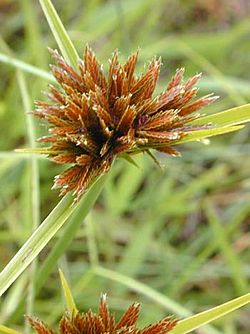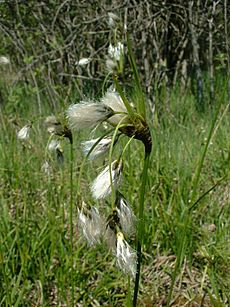Cyperaceae facts for kids
Quick facts for kids Sedges |
|
|---|---|
 |
|
| Cyperus polystachyos flower head | |
| Scientific classification | |
| Kingdom: | |
| Division: | |
| Class: | |
| Order: | |
| Family: |
Cyperaceae
|
| Genera | |
|
About 70 |
|
The family Cyperaceae, also known as the sedges, is a group of flowering plants. They often look a lot like grasses or rushes, but they are actually quite different!
What are Sedges?
Sedges are a very large plant family. There are about 5,500 different kinds, or species, in over 100 main groups called genera. The biggest group is called Carex, which has more than 2,000 species of "true sedges."
Where Do Sedges Grow?
You can find sedges almost everywhere on Earth! Many grow in wild marshes and grasslands. They are also common in wetlands or places with poor soil. When an area is mostly covered by sedges, it's called a sedgeland.
Sedges are especially common in warm, wet places. You'll find many species in tropical Asia and tropical South America.
Useful Sedges
Some sedges are very important to people. For example, the water chestnut (Eleocharis dulcis) is a sedge. Its crunchy, white insides are used in many Asian dishes.
Another famous sedge is the papyrus sedge (Cyperus papyrus). Ancient Egyptians used this plant to make paper!
How to Spot a Sedge
It can be tricky to tell sedges apart from grasses or rushes. But there are a few easy ways to spot them:
- Stems: Most sedges have stems that feel like a triangle when you roll them between your fingers. Grasses usually have round or flat stems.
- Leaves: Sedge leaves grow in a spiral pattern. They come out in three rows, or "ranks," around the stem. Grasses, on the other hand, have leaves that grow in only two rows.
See also
 In Spanish: Ciperáceas para niños
In Spanish: Ciperáceas para niños


